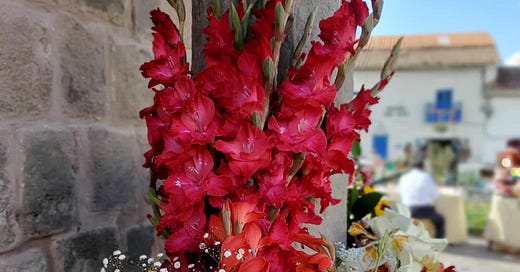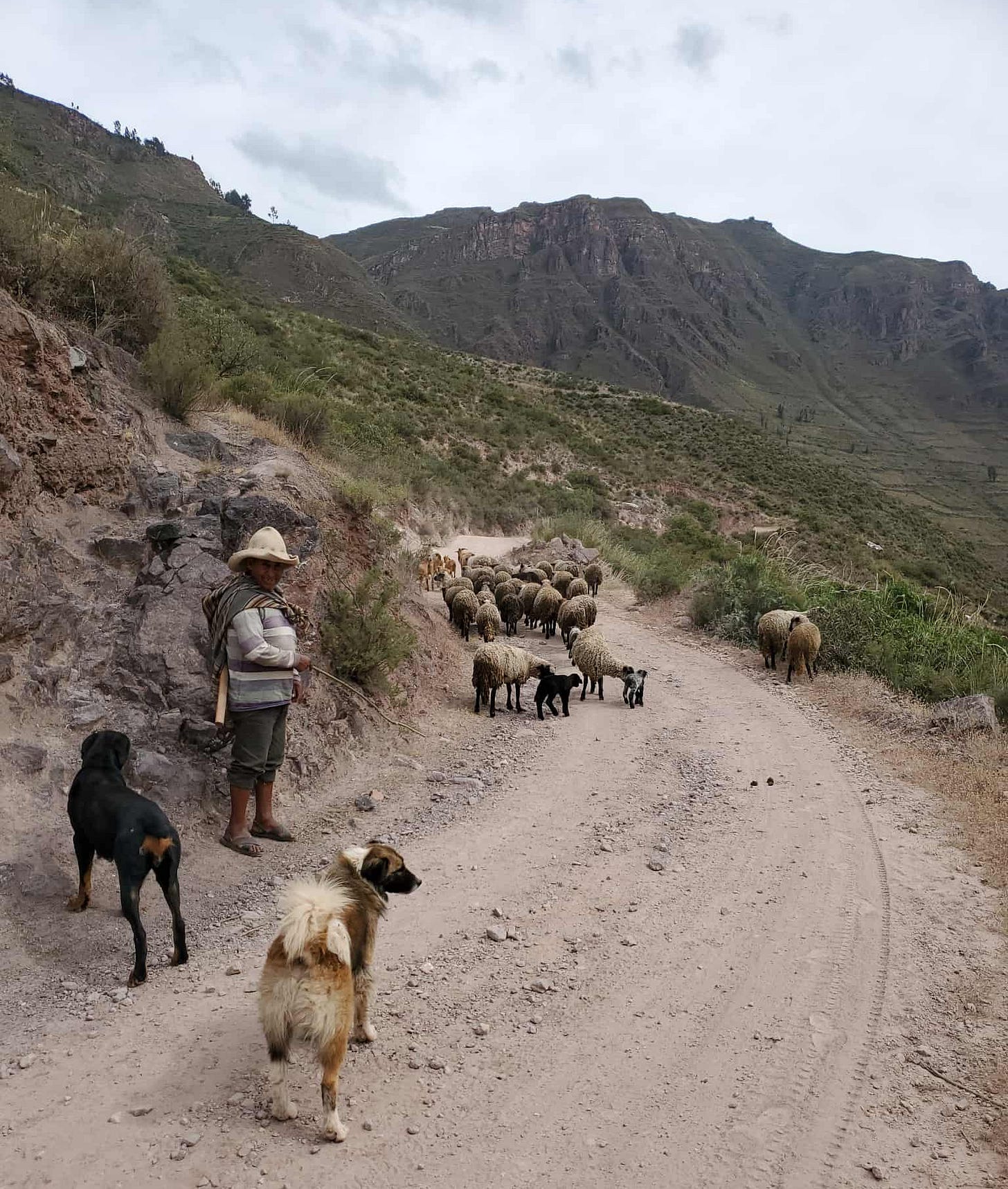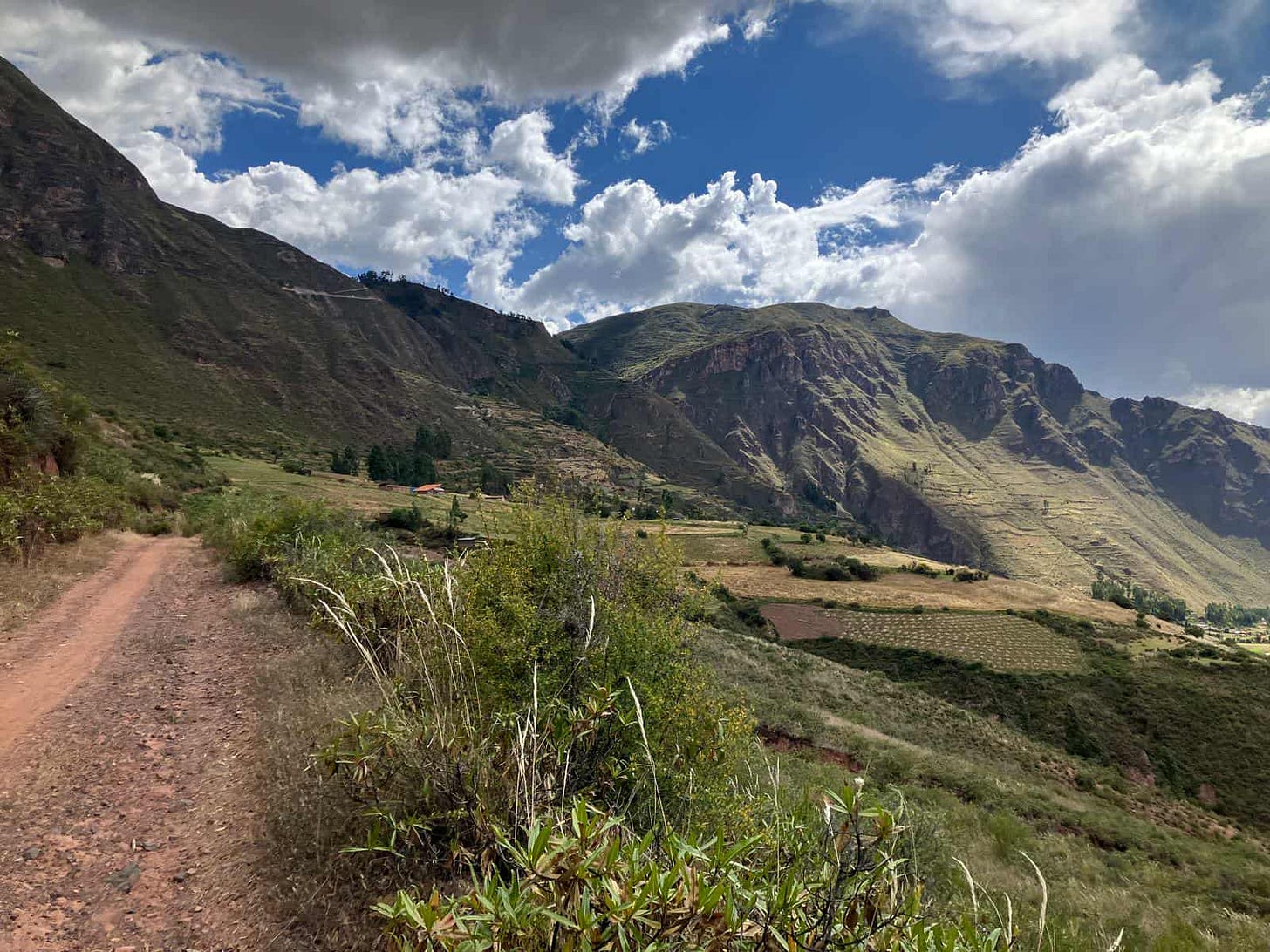These mountains, vital green and breathing, are undeniably alive. They pulse in the slanting rays of the quiet morning sun, predicting the moods and cloud gatherings of each coming day. Alive with uninterrupted ancestral homage, each named, revered, feared, and honored throughout the daily meanderings of the humble and hardworking Quechua people, these mountains are essential companions in the circle of life here in the Sacred Valley, outside the ancient Inca spiritual and political center of Cuzco, Peru, a city in itself deeply embedded with ancestral knowledge and cosmology.
It is said that Pachacuti, ruler of the Inca empire in the mid 1400’s, designed the city of Cuzco to take the shape of a cougar, with the central plaza, now called Plaza De Armas, as the heart of the cougar. The ancient name for the plaza however, in Pachacuti’s time and in the Quechua language, was likely called Huacaypata, whose meaning is debated but centers around “place of ceremony”, “place of weeping”, “place of the warrior” or “sacred place”.

The cosmovision of the ancient peoples can be found throughout the old stonework of the city, representing the three worlds: hanan pacha (sky world, abode of the gods), represented by the condor, kay pacha (present and tangible world), represented by the cougar and ucu pacha (the world below, things not yet germinated), represented by the snake.
In the old way of this land, the apu, or sacred mountain tops, were/are considered a dwelling places of divinity. The term apu typically refers to mountain tops or specific rock configurations near the sacred peaks, but also includes spiritual protectors, forces of nature and deities. From Wikipedia:
Besides mountains, there are other living beings that are considered apu – the so-called Tiqsi Apu. In the Andean tradition, Pachamama (Cosmic Mother), Wiraqucha (God or Cosmic Father), Tayta Inti (Father Sun), Ttita Wayra (Father Wind), Mama Unu (Mother Water), Mama Killa (Mother Moon) and Mama Ch'aska (Mother Stars) can be seen all over the world, which is why they are known as Tiqsi Apu, meaning "Global Apu". Jesus and Mother Mary for the same reason are also known as Tiqsi Apu.
So it was, in the honoring of this particular spirit of local cosmovision, that a hummingbird flew into our home yesterday morning.
As some of you know, I have completely uprooted our family and relocated us from the Rocky Mountains of western Colorado to the Sacred Valley in the Andean Mountains of Peru. The reasons are multi-dimensional, but in finality, it was my dreams that provided the guidance and my meditations that provided the assurance.
I was unsure, of course, exactly what we would encounter through this enormous leap into the unknown, but it has begun to unravel its meaning in a most intimate way, humming at the very roots of it all: Love.
The pace here is slow, gradual, grounded. The earth herself has a tangible presence, almost like we have entered a new world entirely, where the nervous system can settle and there is spaciousness and sweetness in the movements of our daily routines. The earth is present, I mean really really present. The agave are giants and the hummingbirds, twice the size of ours back in the States.
Tall eucalyptus trees tower over our home and also provide the posts and beams within it. Our home is constructed of thick abode walls and centers entirely around a ceremonial fireplace, with an enormous abode chimney, held up on four sides by tall and slender eucalyptus trees, that pulls the smoke out through the roof. Everything is simple, grounded. The water must be meticulously filtered, the lights flicker, we can hear the wind and birds from our bed, the way I like it, and we wake in the company of these extraordinarily alive mountains.
A river runs through the valley here, the old name being Willkamayu, Quechua for sacred river, lined on both sides by vast acres of golden corn fields (which we have since learned, sadly, that most or all of it is GMO, bought from a German seed company). The short and stocky Quechua women are seen carrying enormous bags on their back, filled with corn stalks, green alfalfa bundles, potatoes, roses, or children. They are kind, quiet and speak a language full of sharp staccatos and rolling mouthfuls of ayaa and ñuñaay. Their hands are bronzed by the sun, calloused, stiff.
When we walk the little footpath from our home to the main house here, we can hear them in the fields, talking, laughing, surrounded by the dry crunch of corn husks and stalks being tossed into huge piles. They work together with their children and their husbands, wearing hats and long sleeves and woolen leggings, even in the sharp heat of the day. They work together until the work is done, until the fields of tall dry corn stalks have been transformed into fields of golden fruit, drying in the sun. I mean acres of golden corn, drying in the sun.
So this is where we find ourselves, homing into a new landscape, tuning in to new sounds, feeling a new earth. And what is placed in the center of our altar here, both internal and external, is the pulsing translucence of Love, in its diverse outpourings and tribulations.
We are here to investigate, tend and alchemize the depth and diversity of Love’s imprint in our lives, as you would a garden of a hundred herbs. We are to circle the most basic of human reflections, chanting, grieving, curating a flame of divine resonance in which Life herself can be both born and nourished.
Love is both our cause and our inquiry. It is the fragrance that pulled our feet and finances and dreams to this small community in the Sacred Valley. It is the spell beneath the apparent that tended our journey into the unknown.
But what kind of love is this, growing here on our altar?
Is it the kind of love an apricot feels for the seed growing inside her?
Or is it the kind of love that the seed feels for the tree, that birthed them both?
Is it a love born of fire?
Or a love born of ash?
Is it the kind of love the deer feels for her forest?
Or is it the kind of love a pebble feels for the river that has tossed and softened and polished her, depositing her in the sea, far from her mountain of origin?
Is it the love of wing for wind? Or the love of wind for sea?
Is it a laughing love or a weeping kind?
Is it the love of an Ojibwe woman for her many sisters, the fellow wives of her husband? Is it a love for the hunt, for the family? The love the ancients feel for the stone people curing them in bent willow tree lodges? Or is it the kind of love the stones feel for the songs sung to them in gratitude for the healing?
Is it like the love the Quechua women feel for their fields of corn?
Or is it a mistress kind of love? A hidden love? A secret love, known only in the shadows of marriage?
Is it a convenient love? Compatible?
Is it a love that seeks to consume or to be consumed?
Is it familiar? Is it rooted? Does it flower? Does it serve Life?
Can this love endure the seasons or will it whither beneath the first frost?
Does the fish feel this kind of love for the unknowable presence of Water that continuously and without request, sustains his life?
Is this a dancing love or a resting kind?
What is the capacity of the human heart when held to the Fire?
These are the contemplations born of fire and smoke, in ceremony with the ancient ones. These are the unknowables around which we find ourselves chanting, dancing and weeping, enshrined in a world thieved of wholesomeness, in the heart of an ancient Sun God whose memory lives on by those who survived the famine, disease and conquest. A divine love of Sun for Moon. A love that lives on, despite it all.

✧ ✧ ✧
Thank you for reading this edition of Wild Leaf. May it be of benefit to you and yours. If you like what you read, consider becoming a paid subscriber, or, if you don’t want to pay for a monthly subscription, you can always, Buy Me A Coffee.
Also, I love hearing from you. Leave a comment.
Much love,
Leah







I feel honored to have this peak into your new world! Sounds magical. Sending lots of love to you & your loves.